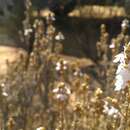en
names in breadcrumbs


Pityrodia is a genus of flowering plants in the mint family, Lamiaceae and is endemic to Australia, most species occurring in Western Australia, a few in the Northern Territory and one in Queensland. Plants in this genus are shrubs with five petals joined to form a tube-shaped flower with four stamens of unequal lengths.
Plants in the genus Pityrodia are evergreen shrubs with erect, usually cylindrical branches. The leaves are simple, net-veined and their bases partly wrap around the stem (decurrent). The flowers may occur singly or in groups and exhibit left-right symmetry. There are 5 sepals which are joined at their bases and 5 petals joined to form a tube. The tube may have 5, unequally sized lobes at the tip or two "lips" - the upper lip having two lobes and the lower one three. There are four stamens with one pair longer than the other. The fruit is a drupe containing up to four seeds.[2][3]
The genus was first described by Robert Brown in 1810. Brown published his description in Prodromus Florae Novae Hollandiae and designated Pityrodia salvifolia as the type species.[1][4] The name Pityrodia is an Ancient Greek word meaning "scale-like".[5]
Pityrodia was originally included in the Verbenaceae. In a review of the genus in 1979, Ahmad Abid Munir included Pityrodia and nine other genera in a family Chloanthaceae, all endemic to Australia and sometimes referred to as "Australian Verbenaceae".[2] The name Chloanthaceae has not been widely adopted and Pityrodia is now included in the Lamiaceae.[6]
In his 1979 paper, Munir described 27 species from Western Australia, 16 from the Northern Territory and one from Queensland,[2] but in 2011, Barry Conn, Murray Henwood and Nicola Streiber transferred some species to Dasymalla, Hemiphora and Quoya and raised a new genus Muniria to which four species of the former Pityrodia were transferred.[7] A new species from Western Australia, (Pityrodia iphthima) has since been described.[6]
The following is a list of Pityrodia species accepted by the Australian Plant Census as at February 2023:[8]
Pityrodia is a genus of flowering plants in the mint family, Lamiaceae and is endemic to Australia, most species occurring in Western Australia, a few in the Northern Territory and one in Queensland. Plants in this genus are shrubs with five petals joined to form a tube-shaped flower with four stamens of unequal lengths.